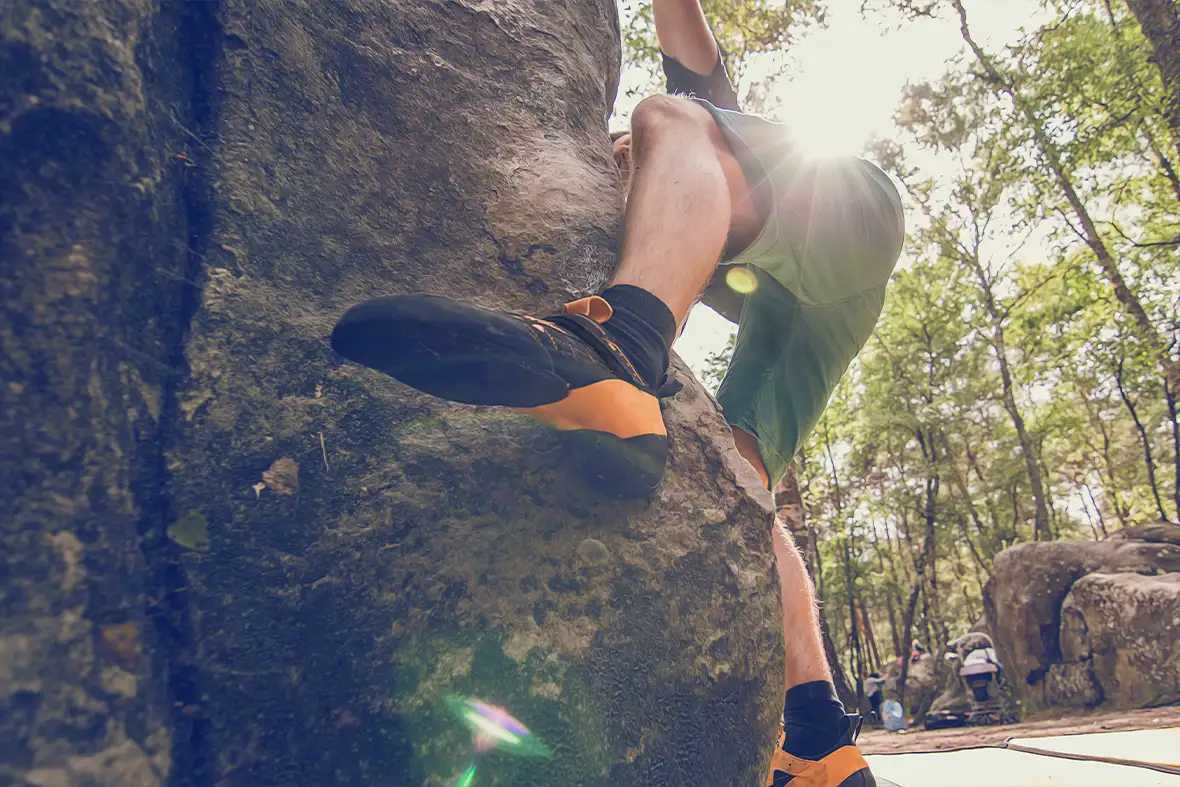Bouldering in Fontainebleau

First time bouldering? Looking for a new adventure or challenge in bouldering? Fontainebleau is just the place. Read our guide to get the most from your trip.
Once a practice ground for 19th century French alpinists, the seemingly never-ending sandstone rocks of Fontainebleau are popular with experienced and beginner climbers alike. Today, the high-quality stone and wide-range of problems and circuits attracts people from all over the globe.
Before you go: Planning your bouldering trip
Planning your trip is sometimes just as much fun as going. When planning a bouldering break, you should consider what you might find at the destination. Here’s some information on Fontainebleau to help you.
There are over 27,000 problems over 245 areas in Fontainebleau (sometimes affectionately shortened to just ‘Font’), so there really is something for everyone, you just have to decide what you want to try. If you are travelling as part of a group, Cuvier Rampart, Canche aux Merciers, and The Cul de Chien are recommended, whereas families and those with younger children could start with Roche aux Sabots, 95.2, or The Elephant.
If you are a beginner boulderer or want to build your confidence, quieter areas such as Chamarande, Troglodyte, Rocher de la Reine, and Pignon Poteau are perfect, with less crowding.
As well as the single boulder problems to climb, Fontainebleau also has circuits, a collection of problems grouped together in different levels of difficulty. Each problem is numbered, and a colour is used to show you how difficult the circuit may be. Expect to encounter slabs, overhangs, cracks, mantles and more as you try out each one.
You can also choose to go ‘off piste’ and boulder the problems that are not part of a circuit. A good guide book will tell you where to find these.

When to go
Spring and autumn are generally suggested as the best times to visit. This is because the risk of rain is lower, and rock and weather conditions are good. Between August-September and April-May the temperature is normally mild and not too hot. During the Easter break in April, Fontainebleau becomes incredibly busy due to the great temperatures, but there are plenty of other activities on offer including hiking and biking.
Bouldering tips for first-timers
A few tips if it’s going to be your first-time bouldering:
- Wear the right kit, especially footwear, which should be fitted correctly before you buy them to make sure they are right for you.
- Ask for advice from others about how they approach problems or difficult circuits. Bouldering is as much about learning as it is developing physical and mental strength.
- Be safe – follow any guidelines or rules at all times and take a spotter or group with you so you aren’t ever bouldering alone.
- Use your legs. This sounds like silly advice, but many beginners will try to use upper strength and arms to lift themselves up, when in fact leg muscles are far better for this.
- Remember it’s not about perfection, if you fail or fall, as long as you are taking safety precautions and wearing the right kit, you will be ok.
- Remember to have fun – this activity is meant to be enjoyable as well as challenging after all!

Fontainebleau bouldering guidebooks
To help you make the most of your trip, there are some highly recommended guide books available. Some are tailored towards more experienced climbers, but many are a great way to learn more about the area and for all levels of bouldering.
For beginners and all levels of bouldering:
- Fontainebleau Climbs: The Finest Bouldering and Circuits, by Jo Montchausse, Francoise Montchausse, Jacky Godoffe
- Jingo Wobbly Fontainebleau Fun Bloc, by David Atchinson-Jones
- Essential Fontainebleau: A Stone Country Bouldering Guide, by John Watson, Colin Lambton
For the more experienced:
- 5 + 6 Fontainebleau: 3975 Straight ups in Central and Southern Fontainebleau, by Bart Van Raaij
- Fontainebleau 7+8: 3748 Straight Ups in Fontainebleau, by Bartvan Raaij

Places to stay
This popular destination offers a few types of accommodation. A gîte is a stone apartment or house which you can easily share with a group of friends, it’s a French word for a holiday home you can rent. They tend to be old farmworkers’ cottages or converted outbuildings and barns full of French character and extremely affordable.
A hostel in nearby La Chappelle-la-Reine offers dormitory and private rooms as well as the option to camp in the garden with full use of the kitchen and common room.
Campsites are scattered around the forest in Fontainebleau, the two most popular being La Musardiere at Milly la Forest and Le Pres at Grez sur Loing.
La Musardiere is walking distance from the bouldering areas and has the added bonus of a swimming pool for days you want to relax. Le Pres at Grez sur Loing is a larger campsite with an onsite shop and a BBQ area.

Driving to Fontainebleau from Calais
You can reach Fontainebleau in a car in around 4 hours via the A26 and A1. Being only an hour's drive south of Paris, you can plan a trip to the capital as part of the drive there, or on your way home.
Loading up a car with all your bouldering kit and driving from the UK is a great way to cut down on costs and allows you to set your own pace and see some stunning scenery en route.

Start your bouldering adventure with LeShuttle
Font offers thousands of routes for different skill levels and is possibly the most famous place in the world for climbers to visit. Start your journey today with LeShuttle.
Join Club LeShuttle
